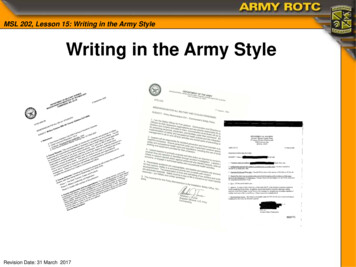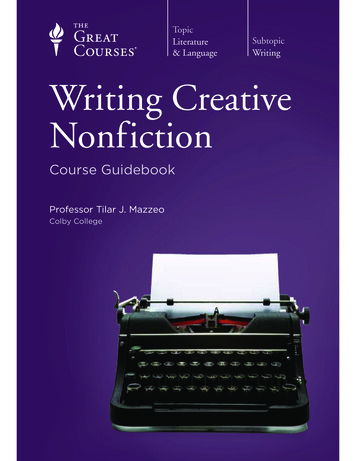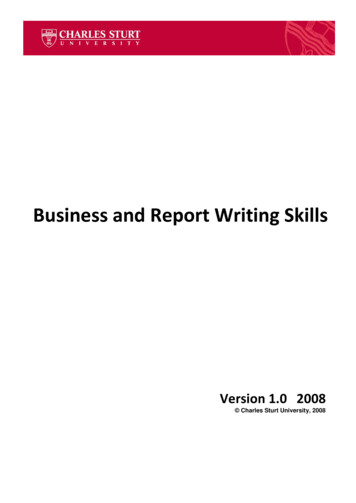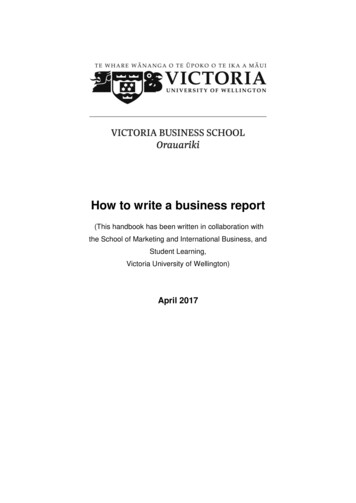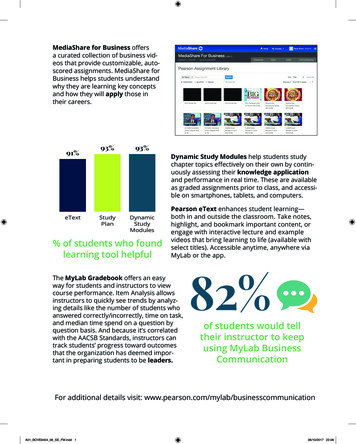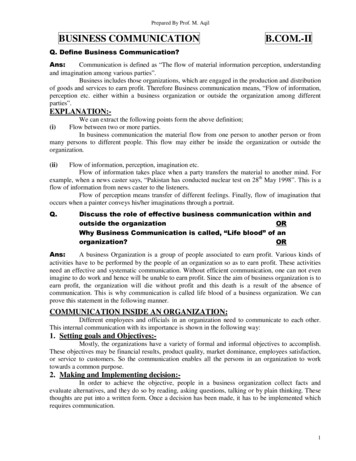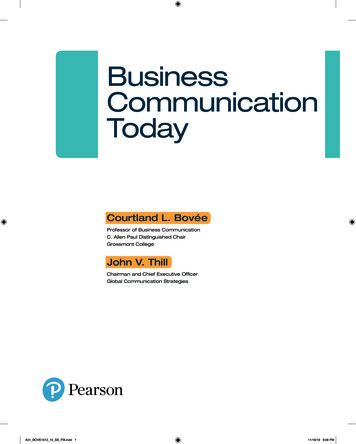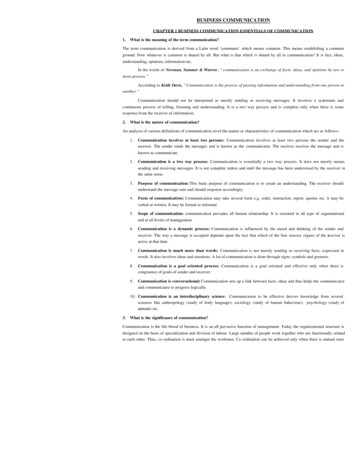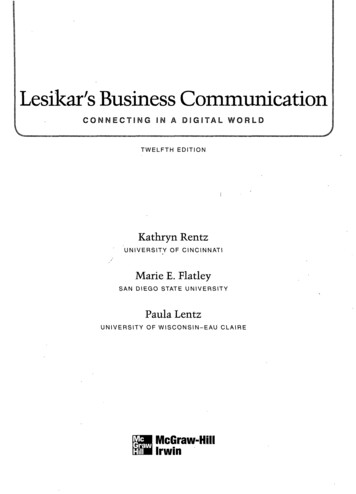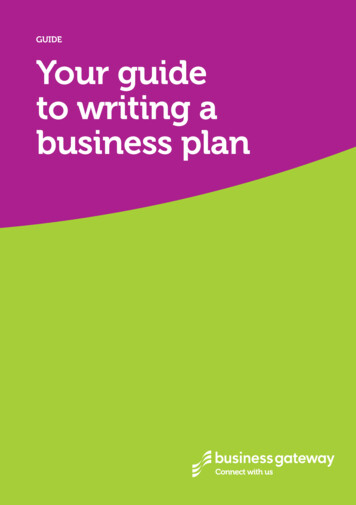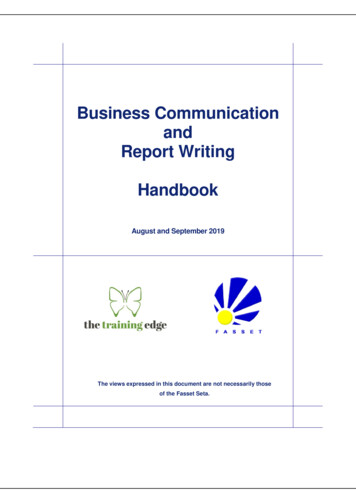
Transcription
Business CommunicationandReport WritingHandbookAugust and September 2019The views expressed in this document are not necessarily thoseof the Fasset Seta.
Business Communication and Report WritingAugust & September 2019Table of ContentsTable of Contents . iiiPurpose . 1Content Outline . 1UNIT 1: INTRODUCTION . 21.Importance of Business Communication . 21.1What is business communication? . 21.2Why is effective communication important in business? . 32.Written Communication – Business Reports . 42.1Types of written communication . 42.2A definition of business reports. 42.3Why do we write reports? . 52.4Characteristics of business reports . 63.Stages of Report Writing . 7UNIT 2: PLANNING . 81.Define the Purpose and Scope of the Report. 92.Consider the Audience . 102.1Who is your target audience? . 102.2How must you adapt the report for the audience?. 123.Gather Information for the Report . 134.Design the Structure of a Business Report . 154.1Memorandum Report . 154.2Letter Report . 15iii
Business Communication and Report WritingAugust & September 20194.3Short Report . 164.4Formal Report . 175.Summary . 22UNIT 3: WRITING . 231.Tips and Techniques to Write Good Reports . 241.1Writing clearly . 241.2Writing concisely . 281.3Making your writing complete . 301.4Writing Correctly . 312.Traps to Avoid when Writing Reports . 333.Write the Report . 344.Summary . 35UNIT 4: REVISING. 361.Proofreading . 372.Do a Quality Check . 392.13.Checklist for review . 40Summary . 41Personal Action Plan. 42iv
Business Communication and Report WritingAugust & September 2019PurposeThe purpose of this intervention is to appreciate the importance of business communication with anemphasis on how to plan, structure, write and revise business reports. Delegates will learn keyconcepts of report writing and explore the technical aspects of how to write a fit for purpose report.Content OutlineIntroductionImportance ng businessreportsStages of ReportWritingPlanningDefine the purposeand scope of thereportWritingTips and techniquesto write goodreportsRevisingProofread thereportConsider theaudienceTraps to avoid whenwriting reportsGather informationfor the reportDo a quality checkDesign the structureof the reportWrite the report1
Business Communication and Report WritingAugust & September 2019UNIT 1: INTRODUCTION1. Importance of Business Communication1.1 What is business communication?Business communication is communication that takes place in the business for organising andadministering business activities. It can include the exchange of ideas, news and views in connectionwith the business.Business communication may be internal or external. Internal communication takes place in meetingsor via written means such as emails, letters, reports etc. External communication takes place withsuppliers, clients or other businesses.A dictionary definition Business communication is the sharing of information between people within anenterprise that is performed for the commercial benefit of the organisation. In addition,business communication can also refer to how a company shares information topromote its product or services to potential tion/business-communication.html2
Business Communication and Report WritingAugust & September 20191.2 Why is effective communication important inbusiness?Communication plays a crucially important role in all aspects of a business and is a building block ofsuccessful organisations. Effective business communication helps build good relationships betweenemployees, which can help increase productivity and the company's bottom line.On the other hand, poor communication in business can result in several unforeseen problems,including disgruntled customers or employees, delayed projects, diminishing productivity and more.Communication is therefore important to your business for the following reasons:Promotes motivationEffective communication can motivate employees and create a sense of engagement and belonging,through the healthy flow of information.Increases productivityThe success of any project is dependent upon the ability of employees to communicate and collaborateas a successful team. Effective communication promotes understanding and builds trust betweenemployees.Helps to grow customer baseCustomers are without a doubt, the lifeblood of the business. Businesses rely on customers for survival.Effective external communication can help attract new customers and retain existing ones.Improves Business Partnerships/RelationshipsAnother important aspect of effective communication is improved partnerships and businessrelationships. Communication is crucial when dealing with suppliers and external business contacts.Sometimes suppliers need to be regularly updated on all products and processes to ensure a smoothflow in the value chain.In this guide, we will focus on how to effectively communicate when writing reports 3
Business Communication and Report WritingAugust & September 20192. Written Communication – Business Reports2.1 Types of written communicationAt work, we communicate in a variety of written formats and for a variety of reasons: To correspond (Memos, letters, emails, SMS etc.) To record and document (Minutes of meetings, notices, registers, agendas etc.) To propose (Research proposals, business proposals, funding proposals etc.) To plan for action (Strategic plans , project plans, action plans etc.) To report on facts about a specific business matter (Product analysis, project report, feasibilitystudy, research report, evaluation report etc.)2.2 A definition of business reportsAs mentioned above, you can write business reports in a range of formats and for a variety of purposes.Whether you need to report on a project, product analysis, a feasibility study, research findings, orsomething else, report writing is a skill you will use again and again.What is a business report? “A business report is an orderly, objective communication of factual informationthat serves some business purpose.” (Lashkar & Petit) “A business report is an impartial, objective, planned presentation of a fact toone or more persons for a specific, significant business purpose.” (Murphy &Hildebrandt) “A formal communication written for a specific purpose that includes adescription of procedures followed for collection and analysis of data, theirsignificance, the conclusions drawn from them and the recommendations, ifrequired.” (Sharma & Mohan)So, a business report can be defined as an organised, written statement of facts related to a specificbusiness matter. It helps the interested persons to get insight into the problem and assists in decisionmaking and problem-solving.4
Business Communication and Report WritingAugust & September 20192.3 Why do we write reports?The prime objective of reports is to help a business to take accurate and pragmatic decisions. Wecompile reports for many reasons:To carry business information to the relevant partiesTo analyse data for interpretationTo help planning by providing factual informationTo help decision-making by providing necessary information and evidenceTo help establish effective control systemsTo help reduce and resolve organisational disputesTo help to bring effective coordination between and among departmentsTo find out the reason behind a problemTo present the findings of an investigation or inquiryTo recommend specific action to solve a problem5
Business Communication and Report WritingAugust & September 20192.4 Characteristics of business reportsAs we know, business reports carry information on facts related to business activities. The very natureof business reports differentiates them from other reports. The unique characteristics of businessreports are discussed below:Specific IssueBusiness reports are written on a specific subject. They are written to fulfil a certain need.Pre-Specified AudienceAn important characteristic of a business report is that it has a specified audience. Usually a report iswritten for a limited number of audiences and the needs of the audience are always kept in mind.Specific Structure or LayoutIn preparing reports, certain structures/layouts/formats are followed.Written on Past EventsIn most of the cases, reports are written on past events. Most business reports carry the reasons forincidents, the ways of recovery etc. Reports are also written in past forms/tense.Neutral in NatureIn drafting reports, strict impartiality must be maintained. No biased or non-objective material isincluded. Biased reports may lead to disastrous decisions.Factual InformationBusiness reports are always written based on factual information. The data collected on specific eventsis factual, not factious.Joint EffortSometimes business reports are an outcome of joint efforts of a group of people – where a committeeis formed (3 to 7 people) to furnish a report on a certain incident.6
Business Communication and Report WritingAugust & September 20193. Stages of Report WritingBreaking down a large task into smaller steps can make the task seem more manageable. If you are inthe process of writing your next report, you may find it easier to view the process as a series of smallsteps.There are three stages to report writing:1. Planning Define the purpose and scope of the report Consider the audience Gather information for the report Design the structure of the report2. Writing Tips and techniques to write good reports Traps to avoid when writing reports Write the report3. Revising Proofread the content Do a quality checkLet’s examine each stage in more detail 7
Business Communication and Report WritingAugust & September 2019UNIT 2: PLANNINGPlanning is a very crucial stage in report writing as it establishes the purpose, context and structure ofthe report. It answers the why, what, how, who and when planning questions. The more thorough youare in the planning stage, the better the report that you write!Planning involves the following steps 1. Planning Define the purpose and scope of the report Consider the audience Gather information for the report Design the structure of the reportLet’s take it from the top 8
Business Communication and Report WritingAugust & September 20191. Define the Purpose and Scope of the ReportThe first step is to define the purpose of the report. The purpose of the report could be to share an idea,answer a question, solve a problem, or share information. Make sure that you can describe the purposeof the report in straightforward terms. This will help you to keep your information clear when you startto write.To help define the purpose and scope of the report – think of a possible report you may have to writein the near future and provide answers to the following questions. Note that this report will be referencedthroughout this intervention as your Case Study:Question Response Why must you produce the report – forwhat purpose? What business issue is the report goingto address? What factual information must the reportcontain? What problems will the report shareinsights on? What decisions will the report help tomake? What is the scope of the report – whatwill it focus on? What will be included, excluded? Anything else?Once you have established the purpose of the report, you must consider who the audience for the reportis.9
Business Communication and Report WritingAugust & September 20192. Consider the AudienceAn important aspect of report writing is to consider your audience. Unlike letters and memos - reportsand proposals have a far wider distribution. Readers of your report may be involved in the problemsolving or decision-making process, so your job is to make it easy for them to understand the informationand data presented. In order to make reading the report easier, think in terms of the reader.2.1 Who is your target audience?To analyse the needs of the target audience, respond to the questions in the table below (following onfrom the previous Case Study):QuestionResponse PrimaryPeople who must act or make decisions based onthe documentWho is your audience?SecondaryPeople who will be affected by actions the primaryThere are three basicaudience is going to take in response to theaudience types:documentIntermediatePeople responsible for evaluating the documentand passing it on the right people10
Business Communication and Report WritingAugust & September 2019QuestionResponse Primary What are theneeds of eachSecondaryaudience type –relevant to thereport?IntermediateFor the Primary Audience, answer the following:What do they expect to learn fromthe report?What do they already know?What don’t they know that must beincluded in the report?Do they hold certain biases orpreferences that will impact on theinterpretation of the report – andhence decision-making or problemsolving?What positions do they hold in theorganisation?What are their levels of education /work experience relevant to thereport?What decision making powers dothey have relevant to the report?Anything else?11
Business Communication and Report WritingAugust & September 20192.2 How must you adapt the report for the audience?Based on the above analysis of the audience, what must you consider and / or adapt in your report tocater for the various needs?Some things you may consider for adaptation are: The use of jargon and technical terms Level of the language used in the report Scope of the report Focus of the report The level of detail in the report Strategies to handle possible contentious or sensitive issues, given the target audience, etc.Now that you have a handle on the audience, the next step is to gather relevant information, capableof addressing the purpose, scope and issues that the report must address.12
Business Communication and Report WritingAugust & September 20193. Gather Information for the ReportThis step involves gathering information that will go into the report. Expert opinions and hard numbersoften form the core of many business reports.How do you gather accurate information for a report, and how do you choose what to includeand exclude?Following these guidelines will ensure that what you gather is accurate: Collect your evidence before you write by observing, interviewing, doing research and gatheringdata. Organise your evidence. Keep your evidence clear of your opinions. Make sure that personal bias isn’t skewing theevidence by letting how you feel get in the way of what you gather.In most studies, you will gather masses of information and you must be selective about what goes intoyour report. Your selection should be based on: The purpose of your report. What is it meant to achieve? The people to whom it is directed (the reader or readers). You have to decide what the readersalready know and what they need to know.Unless you are an unquestioned authority on your subject matter,your opinions will only carry asmuch weight as the evidence that you can gather. The more evidence you can collect before writing,the easier your writing will be.Evidence consists of the facts and information you gather in three ways: Careful observation Interviews Research (in your company library or archives, surveys, statistical review, etc.)In order to make sure that your report is not biased, don’t focus only on evidence thatwill support your argument. You need to objectively present the positive and negativeresults for people to see the integrity in your data and the report.13
Business Communication and Report WritingAugust & September 2019To give formal reports credibility and authority, researchers generally rely on a certain amount ofsecondary data, obtained in print or electronically.Consider the following pointers when planning to gather information for business reports: What information do you want to gather? How will you gather the information, i.e. observation, documentary review, interviews, etc.? What sources will you gather data from? From whom or where? How will you analyse and interpret the information you have gathered?A challenge!Write down possible sources you might use to gather information for each of thesereport topics:Your Case StudyResults of 360-degree performance reviewsHow much succession planning theaccounting department has done?The efficiency of different types of projectmanagement softwareSafety issues in your workplaceTrends in the financial industry14
Business Communication and Report WritingAugust & September 20194. Design the Structure of a Business ReportThere are several basic formats or approaches to writing reports. The type that you use will depend onhow formal the report needs to be, and how much detail your readers need. You can write internalreports (memorandum report), a letter style report, a short report, or a formal report.Reports typically make use of headings and sub-headings to separate the information.This gives your reader a break from reading solid pages of text and also allows peopleto find what they want to read quickly.The different report types are presented here from the least to the most formal.4.1 Memorandum ReportThis format looks like a regular memorandum (memo) at the top. It is helpful as a short report aboutinternal matters, and is not sent to anyone outside the company. A memorandum report can be helpfulfor reporting on internal sales figures, letting a manager know how the team has performed during theweek, or to provide an interim update on an inventory. Since this is an internal document, it can be objective and impersonal. Simple headings and text that is flush left in bold or italics are often used for quick referencing. The report may be initialled at the beginning, where the sender’s name is noted, or signed atthe bottom (four lines after the text ends and typed above a signature line) or left unsigned. Your standard company memo format is used on the first page, and subsequent pages areprinted on plain paper.4.2 Letter ReportThe letter format is practical for informal reports that run several pages. Since it is in a letter format, itcan also be used for people or groups outside of the organisation. These reports are typically used byoutside consultants to provide updates on project analyses or recommendations. The letter format mayalso be used by a Board of Directors to describe changes and developments to stakeholders. The first page of a letter report is typed on letterhead stationery, with plain paper used forsubsequent pages. Opening with a subject line replaces a title, and simple headings (as in the memo report) addemphasis and clarity.15
Business Communication and Report WritingAugust & September 20194.3 Short ReportShort reports are distinct from memo and letter reports in both scope and format. They may includeseveral of the same elements of a formal report, such nTables and graphics ifrelevantRecommendationsTitle pagePreliminary summary(including conclusion &recommendationsAuthorisation detailsStatement of theproblem16
Business Communication and Report WritingAugust & September 20194.4 Formal ReportFormal reports are a sophisticated presentation. They are more complex and longer than the otherformats due to the content. A formal report may include all of the following elements, which are oftendescribed in company policy in order to keep reports consistent throughout an organisation.OverviewCoverIncludes the title and author’s name, and may be on a label attached to the cover if the cover is nota printable material. (Coloured or clear plastic is often used.)FlyleafA blank page following the cover. There can also be one at the end of the report, where people canwrite comments if they want to.Title PageTitle of the report, who the report was prepared for (name and title of recipient), author’s name,position, department and / or address and date.Letter of AuthorisationIf the writer received written authorisation to undertake the report, the letter or memo may be insertedhere. If authorisation was verbal, then a note describing who provided authorisation can be part ofthe letter of transmittal or the introduction (described below).Letter of TransmittalExplains how, why, and under what circumstances the report was prepared. This may also be apreface to the report. This document outlines the purpose of the report, its scope, any limitations tothe report and the research methods used. This letter often ends with a thank you for the assignmentand openness to answer any questions about the report. This letter is printed on a letterhead andsigned by the author.Foreword or PrefaceOften completed by someone other than the writer, such as a department head or other stakeholder.IntroductionSynopsis or Executive SummaryAn informative summary covering the purpose of the report as well as key findings, conclusions andrecommendations.Table of ContentsContains main divisions with page numbers.List of Figures or IllustrationsNeeded only if there are many illustrations and graphs.IntroductionIncludes whatever the reader needs in order to understand the report, such as background, scopeand limitations; details about your approach or method; and criteria used in making your evaluation.17
Business Communication and Report WritingAugust & September 2019BodyBodyThe “meat” of the report.SummaryTells your reader what you set out to do and what your findings are.ConclusionConclusionsSummarises the facts in the report and spells out the conclusions.RecommendationsOffers recommendations based on the conclusions.AnnexuresAppendixMay include statistics, tables and other information of interest. This is information that would only beuseful to some readers and would therefore not be appropriate in the body of the report.GlossaryHelpful if your readers are not familiar with vocabulary used in the report.IndexNot required, but helpful in extensive reports.ReferencesVery extensive reports may also contain footnotes or endnotes and a bibliography.Notes Some of the elements listed above may be left out, depending on the nature of the report andthe audience. For example, a letter of transmittal may be waived depending on the informationin the foreword. Reports that are long are normally bound on the left margin, so wide left-hand margins and rightflush page numbers are appropriate. The opening pages (excluding the title page) are normally paginated with lowercase Romannumerals (i, ii, iii, iv, etc.), while the rest of the report is paginated with Arabic numerals (1, 2,3, 4, 5, etc.).18
Business Communication and Report WritingAugust & September 2019A challenge!Prepare the outline structure of a report on the topic of your Case Study. Fill in asmuch of the detail in summary/bullet form as you can, leaving out the detail that youcannot complete like the research findings.Use the template below to help structure the outline of the usionTables and graphics ifrelevantRecommendationsTitle pagePreliminary summary(including conclusion &recommendationsAuthorisation detailsStatement of the problem19
Business Communication and Report WritingAugust & September 2019A challenge!20
Business Communication and Report WritingAugust & September 2019A challenge!21
Business Communication and Report WritingAugust & September 20195. SummaryThat concludes the first stage of report writing – Planning. Proper planning sets you up with a solidfoundation from which to write the report.1. Planning Define the purpose and scope of the report Consider the audience Gather information for the report Design the structure of the report2. Writing Tips and techniques to write good reports Traps to avoid when writing reports Write the report3. Revising Proofread the content Do a quality checkNext we focus our attention on how to write the report.22
Business Communication and Report WritingAugust & September 2019UNIT 3: WRITINGNow that you have planned and prepared to write the report, it is time to put it all together and write thereport. When you start writing your report, you are really getting to the heart of your message.In this unit, we will explore the following:2. Writing Tips and techniques to write good reports Traps to avoid when writing reports Write the report23
Business Communication and Report WritingAugust & September 20191. Tips and Techniques to Write Good ReportsWhen you write well, you are saying that you have thought about your message, have taken the timeto understand the reader, and you want to send a positive image of yourself.With the proper attitude, a respect for how words work together and knowledge of usage conventions,your writing can be clear, concise, complete, correct and easy to read.1.1 Writing clearlyWriting is like other forms of communication. You want people who receive your reports to understandwhat you are saying.People are inundated with things to read. If you tend to pad your writing with extra words and “fluff”,they will probably feel that their time is wasted. Poorly written documents will go to the bottom of thepile and may not be read at all.What do you think this manager meant in the following message?“Personnel assigned vehicular space in the adjacent areas are hereby advised thatutilisation will be suspended temporarily on Friday morning.”You would probably have read that sentence several times before you understood that you are beingadvised not to park in the lot next door on Friday morning.Clear messages contain words that are familiar and meaningful to the reader. Whenever possible, useshort, common, simple words to say what you mean.Let’s find out how to write more clearly.24
Business Communication and Report WritingAugust & September 2019Familiar wordsLook at the following list. Can you decide which words your audience would be more familiar with?AscertainFind se wordsWhen you consider what you need to say and how to say it, don’t give up a precise word if it saysexactly what you mean. Let’s look at some examples: “The report was on time,” is not as precise as, “The de
Business communication is the sharing of information between people within an enterprise that is performed for the commercial benefit of the organisation. In addition, business communica

